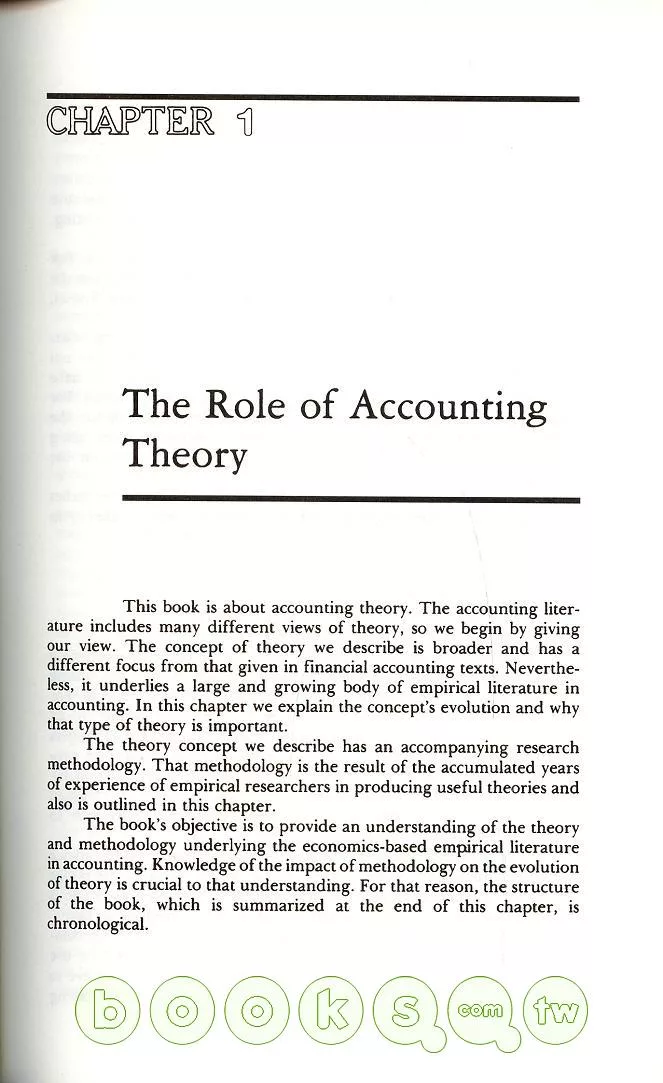This book reviews the theory and methodology underlying the large and growing economics-based empirical literature in account-ing.Theory does not present a rule for choosing among alternative
accounting procedures(e.g.,choose the one that better matcher revenue and expense).Rather,theory provides an explanation for accounting and auditing practice.For example,a theory explains why
some firms use accelerated depreciation methods and others use straight line and why some firms use Big Eight auditors and others do not.Such a theory is important to accountants and
managers;it helps them to make better decisions when conditions change and they are confronted with unfa-miliar situations.
The theory,as it currently exists,is far from complete.In fact,the investigation into the factors affecting accounting and auditing practice is just beginning,and the causes of the empirical
regularities that have been observed are still debated.This is expected because the world is complex and continually changing.Complexity and change ensure that we will never have a complete
theory of accounting.
Interpretations of associations between variables requires a theory.Hence,empirical research is not a question of discovering facts about accounting and auditing.A researcher explicitly
specifies a hypothesis from a theory and tests it.If the hypothesized relation is substantiated,the theory is used to interpret the findings.However,often the researcher’’s evidence causes the
theory to be revised and new hypotheses to be generated and tested.The result is that theory evolves over time,and a current survey of the state of the research often interprets and early study
in a fashion very different from the original researcher.
Presenting the empirical research with only current-day interpre-tations of the results is misleading and does not give the student an understanding of how research evolves.Consequently,the
literature is analyzed chronologically in this book.In Chapters 3—6 we analyze the early applications of empirical work in financial economics to account-ing.These studies addressed hypotheses
underlying the existing ac-ing.These studies addressed hypotheses underlying the existing ac-counting literature.Evidence provided by these studies(combined with theoretical developments in
finance)led to the formulation of a new accounting theory presented in Chapters 8—10 and 14. Thedevelopment of the new theory was also spurred by an ongoing debate over the desirability of
government regulation of financial disclosure,a debate that is analyzed in Chapter 7.Studies empirically testing hypotheses of the new theory are summarized and evaluated in Chapters 11,12,and
13.
Our chronological approach has its costs.Studies addressing the same question appear in different chapters.For example,investigations of the stock price effect of changes in accounting
procedures appear in both Chapters 4 and 12.However,we think that cost is offset by the benefit the student receives in understanding the research process.
In analyzing important studies in the development of the lierature,we try to explain the methodology underlying the literature.That methodology is rarely taught,even in economics and finance
Ph.D. programs.It is learned by hands-on experience in conducting empirical studies and is passed on to colleagues and Ph.D.students in workshops and seminars,the refereeing process,and
published reviews of past research.We discuss empirical methodology explicitly in Chapter 1.Our purpose is to give students the benefit of the accumulated years of experience of researches in
producing useful theories.
The single-period capital asset pricing model(CAPM)is used throughout the book as the valuation model.The CAPM is simple,yet as powerful as more complicated models in yielding an underlying
framework for deriving testable implications.
The prerequisites for this book include an elementary knowledge of accounting,price theory(microeconomics),finance,and statistics(including multivariate regression analysis).Some knowledge of
the material in standard intermediate and advanced financial accounting texts is helpful but not necessary.
The book is written and has been used for a second-year M.B.A.and Ph.D.audience.While our students are well prepared,they still find the level of sophistication and rigor challenging.Several
chapteres are difficult for M.B.A.students.Subtle methodological or theoretical points are addressed rather than ignored or glossed over.The process of discussing the issue illustrates that it
is far from being understood.
Some students prefer toe know just”the bottom line.”Unfortu-nately,a tidy’’bottom line’’does not exist at the present time.We are dealing with the shifting sands of a body of research.Our
purpose is not so much with presenting a map of the current sands as with providing students with the tools and understanding to draw their own maps of,and contribute to,future
literature.
An important and well-received supplementary teaching aid used in the M.B.A.course has been a term paper analyzing current proposed or recently adopted accounting standards(e.g.,deferred
taxes).In particular,the assignment requires student teams to analyze the cash flow effects of various standards,the parties benefited and harmed by the standards,and the circumstances causing
the standards to be placed on the standard board’’s agenda.This project illustrates how the book’’s theory can be used to explain current accounting controversies and pulls together the various
theoretical issues raised in the book.Time permitting,these projects provide students with useful experience making class presentations and expose students to applications of the theory to
other recent controversies.
There are two points of style that should be explained.Each chapter finished with a summary.And whenever important concepts are introduces,they are set in boldface type.
Students have provided(often involuntary)「consumer」feedback,thereby helping us to discover some hidden land mines.Comments and editorial assistance from Susan Thomas,Jan Baker Pass,and Chris
Surrette were particularly useful.Several colleagues provided helpful discussions and insightful and critical remarks on earlier versions:Andrew Christie,Linda DeAngelo,Michael Jensen,Martin
Geisel,William Meckling,G.William Schwert,Clifford Smith,Lee Wakeman,and jerold Warner.And most important,Pat Baldeck and Chris Haszlauer supplied large inputs of document processing.Daniel
Collins,George Foster,Robert Holthausen,Richard Leftwich,and Alfted Rappaport reviewed earlier versions of the manuscript.Financial as-sistance was provided by the Center for Research in
Government Policy in Business and the Managerial Economics Research Center,both at the Graduate School of Management,University of Rochester.To all these individuals and institutions we offer
our sincere gratitude.
Ross L.WATTS
JEROLD L.ZIMMERMAN




























